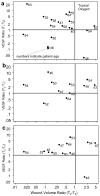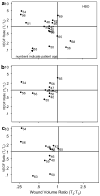Topical oxygen therapy induces vascular endothelial growth factor expression and improves closure of clinically presented chronic wounds
- PMID: 18430064
- PMCID: PMC2574754
- DOI: 10.1111/j.1440-1681.2008.04934.x
Topical oxygen therapy induces vascular endothelial growth factor expression and improves closure of clinically presented chronic wounds
Abstract
1. Chronic wounds, especially in diabetics, represent a serious threat to human health. 2. Correcting a compromised state of tissue oxygenation by the administration of supplemental O(2) is known to benefit wound healing. Beyond its role as a nutrient and antibiotic, O(2) supports wound healing by driving redox signaling. 3. Hyperbaric oxygen (HBO) therapy is widely used and approved by Center for Medicare and Medicaid Services to treat specific ulcerations. The current literature supports the notion that approaches to topically oxygenate wounds may be productive. 4. Here, we present the results of two simultaneous studies testing the effects of HBO and portable topical oxygen (TO) therapies. These two therapeutic approaches have several contrasting features. 5. In total, 1854 patients were screened in outpatient wound clinics for non-randomized enrolments into the HBO (n = 32; 31% diabetic) and TO (n = 25; 52% diabetic) studies. 6. Under the conditions of the present study, HBO treatment seemed to benefit some wounds while not benefiting others. Overall, HBO did not result in statistically significant improvements in wound size in the given population over the time monitored in the present study. 7. However, TO significantly improved wound size. Among the three O(2)-sensitive genes (VEGF, TGFbeta1 and COL1A1) studied in wound edge tissue biopsies, TO treatment was associated with higher VEGF165 expression in healing wounds. Expression of the other genes mentioned was not affected by TO. There was no significant change in the expression levels of any of genes studied in patients in the HBO study. This establishes a link between VEGF gene expression and healing outcome for TO therapy. 8. Taken together, the present study provides evidence demonstrating that TO treatment benefits wound healing in patients suffering from chronic wounds. Treatment with TO is associated with an induction of VEGF expression in wound edge tissue and an improvement in wound size.
Figures





Similar articles
-
Tissue-specific role of Nrf2 in the treatment of diabetic foot ulcers during hyperbaric oxygen therapy.Free Radic Biol Med. 2019 Jul;138:53-62. doi: 10.1016/j.freeradbiomed.2019.04.031. Epub 2019 Apr 26. Free Radic Biol Med. 2019. PMID: 31035003
-
Hyperbaric oxygen attenuates apoptosis and decreases inflammation in an ischemic wound model.J Invest Dermatol. 2008 Aug;128(8):2102-12. doi: 10.1038/jid.2008.53. Epub 2008 Mar 13. J Invest Dermatol. 2008. PMID: 18337831
-
Enhancement of wound healing by hyperbaric oxygen and transforming growth factor beta3 in a new chronic wound model in aged rabbits.Arch Surg. 2000 Oct;135(10):1148-53. doi: 10.1001/archsurg.135.10.1148. Arch Surg. 2000. PMID: 11030870
-
Oxygen in wound healing: nutrient, antibiotic, signaling molecule, and therapeutic agent.Clin Plast Surg. 2012 Jul;39(3):293-310. doi: 10.1016/j.cps.2012.05.001. Epub 2012 Jun 2. Clin Plast Surg. 2012. PMID: 22732377 Review.
-
Revisiting the essential role of oxygen in wound healing.Am J Surg. 2003 Sep;186(3):259-63. doi: 10.1016/s0002-9610(03)00211-3. Am J Surg. 2003. PMID: 12946829 Review.
Cited by
-
Microfluidic wound bandage: localized oxygen modulation of collagen maturation.Wound Repair Regen. 2013 Mar-Apr;21(2):226-34. doi: 10.1111/wrr.12021. Epub 2013 Feb 25. Wound Repair Regen. 2013. PMID: 23438079 Free PMC article.
-
Fluorinated Methacrylamide Chitosan Hydrogel Dressings Improve Regenerated Wound Tissue Quality in Diabetic Wound Healing.Adv Wound Care (New Rochelle). 2019 Aug 1;8(8):374-385. doi: 10.1089/wound.2018.0887. Epub 2019 Jul 25. Adv Wound Care (New Rochelle). 2019. PMID: 31346492 Free PMC article.
-
Salvage of Unilateral Complete Ear Amputation with Continuous Local Hyperbaric Oxygen, Platelet-Rich Plasma and Polydeoxyribonucleotide without Micro-Revascularization.Arch Plast Surg. 2017 Nov;44(6):554-558. doi: 10.5999/aps.2017.00451. Epub 2017 Oct 27. Arch Plast Surg. 2017. PMID: 29076317 Free PMC article.
-
Topical Oxygen for Chronic Wounds: A PRO/CON Debate.J Am Coll Clin Wound Spec. 2014 Dec 19;5(3):61-5. doi: 10.1016/j.jccw.2014.12.003. eCollection 2013 Dec. J Am Coll Clin Wound Spec. 2014. PMID: 26199891 Free PMC article. Review.
-
Evidence-based practice standards for the use of topical pressurised oxygen therapy.Int Wound J. 2012 Jun;9(3):271-84. doi: 10.1111/j.1742-481X.2012.00956.x. Epub 2012 Apr 11. Int Wound J. 2012. PMID: 22494402 Free PMC article. Review.
References
-
- Gordillo GM, Sen CK. Revisiting the essential role of oxygen in wound healing. Am J Surg. 2003;186:259–63. - PubMed
-
- Kurz A, Sessler D, Lenhardt R. Perioperative normothermia to reduce the incidence of surgical wound infection and shorten hospitalization. NEJM. 1996;334:1209–1215. - PubMed
-
- Grief R, Akca O, Horn EP, Kurz A, Sessler DI. Supplemental perioperative oxygen to reduce the incidence of surgical-wound infection. Outcomes Research Group.[see comment] New England Journal of Medicine. 2000;342:161–7. - PubMed
-
- Sen CK. The general case for redox control of wound repair. Wound Repair Regen. 2003;11:431–438. - PubMed
Publication types
MeSH terms
Substances
Grants and funding
LinkOut - more resources
Full Text Sources
Other Literature Sources
Medical
Miscellaneous

